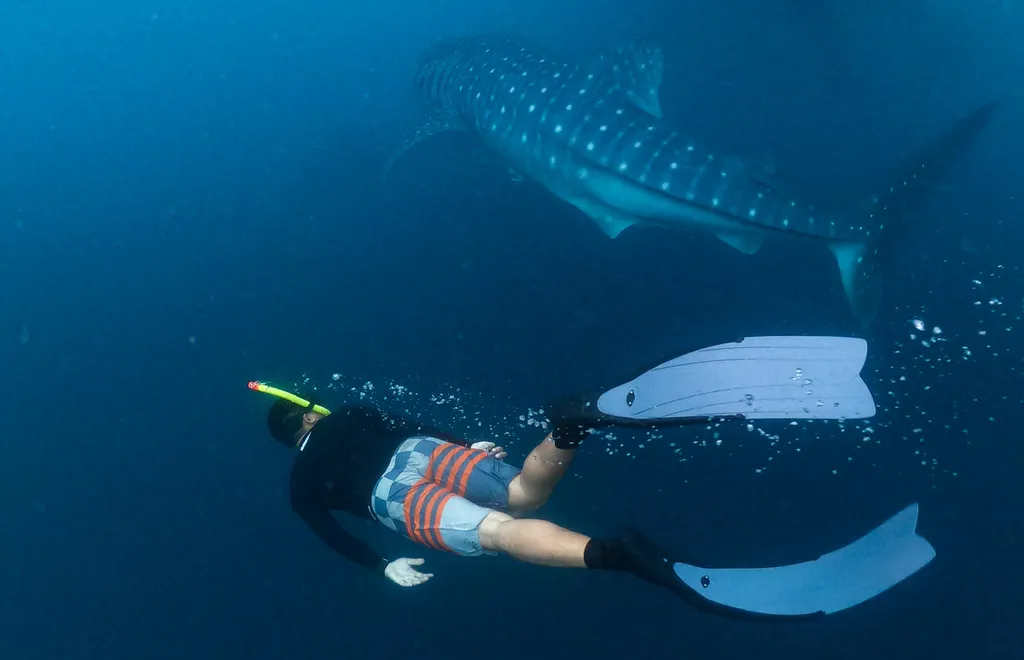If you’ve ever been to a small fishing village in Sumbawa, Indonesia, you know how life there moves at a different pace. Roosters crow early, the sea breeze carries the scent of salt and grilled fish, and wooden boats glide silently through the morning mist. But what might surprise you most isn’t the simplicity — it’s the presence of giants. Right here, in these calm waters, lives one of the largest creatures on Earth: the whale shark.
And yet, in this remote bay, these gentle giants are not feared or driven away. They are respected. They are part of the rhythm of life. This is the story of how local fishermen and the whale shark in Sumbawa have learned to live side by side — not just surviving, but coexisting in a way that feels almost poetic.
My First Encounter in Saleh Bay
When I first signed up for a trip to see whale sharks in Saleh Bay, I expected wonder. What I didn’t expect was to witness something so beautifully human.
We set off before sunrise, with the motor humming softly and the guide sharing stories of previous sightings. As we floated over the deep blue, a calm voice from the captain said, “There.”
And there it was — a massive whale shark, gently rising toward the surface like a submarine from the deep. No chaos, no chase. Just a quiet, respectful approach. We watched, awestruck.
But what stayed with me wasn’t just the animal — it was the interaction between the fishermen and the sharks.
The Fishermen Know Their Visitors
In the villages near Saleh Bay, fishermen don’t need sonar or fancy tech. They know the sea by feel, smell, and memory. And over time, they’ve learned the habits of the whale sharks. Some even recognize individual sharks by their spot patterns.
“They come when the anchovies are plenty,” said Pak Rahman, a local fisherman I chatted with that afternoon. “They don’t bother us. We don’t bother them.”
This mutual understanding didn’t happen overnight. But over years of observation and adaptation, the fishermen realized the whale sharks posed no threat — in fact, their presence often meant a healthy ocean.
Feeding, Fishing, and Finding Balance
During anchovy season, fishermen lower their nets and lights to attract schools of fish. Sometimes, whale sharks show up, drawn by the same bait.
In many parts of the world, this overlap could create conflict. Here? It’s the opposite.
Fishermen in Sumbawa have adapted their methods to ensure the whale sharks aren’t harmed. They raise their nets slowly. They avoid entangling gear. They spread the word when sharks are nearby, and even warn tourists to keep their distance.
One boat operator told me proudly, “We’re not just showing people the sharks. We’re showing them respect.”
A New Kind of Tourism: One That Includes the Locals
This way of life is now part of what makes Saleh Bay whale shark tour so unique. It’s not a zoo. It’s not a spectacle. It’s a living ecosystem, where fishermen, tourists, and wildlife intersect naturally.
When tourists come, they don’t just see the sharks — they meet the people who live with them every day. They listen to the fishermen’s stories, eat lunch in their homes, and learn about the sea from the ones who know it best.
This type of eco-tourism doesn’t just preserve marine life — it uplifts communities. It makes conservation personal. And it creates economic alternatives to destructive practices like overfishing or coral blasting.
Lessons from the Ocean’s Gentle Giant
Watching a whale shark swim feels like meditation. Slow, unbothered, powerful yet peaceful.
That vibe seems to have rubbed off on the fishermen here, too. There’s no rush. No need to dominate nature. Just harmony.
It made me think: coexistence isn’t just about survival. It’s about trust. Between humans and animals. Between the past and the future.
The fishermen didn’t need scientists to tell them the whale shark is harmless. They figured it out on their own. They adapted. They chose protection over profit. That’s a lesson we could all learn from.
Community Pride and Global Eyes
Since this peaceful relationship has started gaining international attention, there’s been a noticeable shift in the community. Young people, who once dreamed of leaving the village for the city, now see value in staying.
Some become guides. Others start homestays or sell handicrafts. Schoolchildren learn about conservation — not from textbooks, but from their uncles and grandfathers who work on the sea.
There’s a pride that comes from knowing the world is watching — not because of problems, but because of the example they’ve set.
Not Just a Trip, But a Transformation
My journey to Saleh Bay was supposed to be about ticking something off my bucket list. Swim with a whale shark? Check.
But what I got instead was a different kind of experience. One that reminded me that the best travel moments aren’t always the adrenaline rush. Sometimes, they’re the quiet ones — the slow mornings on the boat, the warm smiles from villagers, the realization that balance is possible.
Now, every time someone asks about my trip to Sumbawa, I don’t just show them photos of the whale shark. I tell them about Pak Rahman. About the nets raised with care. About the kids who waved as we left the shore.
Because that’s the real story.


